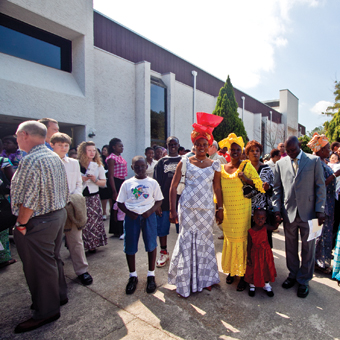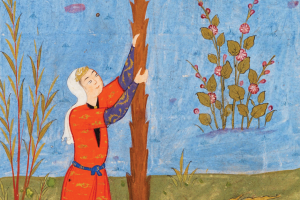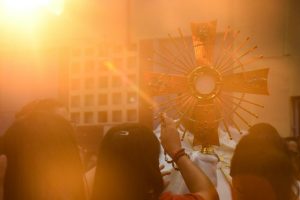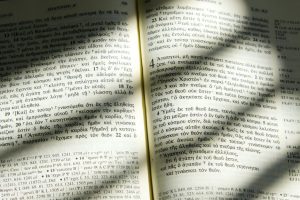Parishes cross barriers of language and culture to make their Sunday celebrations more inclusive.
When Gini Eagen came to Corpus Christi Catholic Church in Stone Mountain, Georgia three decades ago, the parish had “a very white population,” she says. Now Eagen is the church’s pastoral associate, and things have changed. “We are today the Catholic Church I used to picture in my prayer life,” she says. “When you’re young and you hear that there are people all over the world saying the same prayers that you say, you can picture it, but this is the reality we can see on Sunday.”
Corpus Christi has parishioners from Sudan, Burundi, Congo, Kenya, Nigeria, Eritrea, Mexico, Jamaica, Colombia, Cuba, and Peru—among others.
“You name it, we got some,” laughs pastor and U.S. Catholic editor Father John Molyneux, C.M.F. “The town next to where we live in Stone Mountain is where Georgia has chosen to settle the refugees; therefore whoever comes we settle into our parish because we’re the closest Catholic parish.”
The community’s diversity might have transformed it into Eagen’s childhood ideal, but it has also created challenges. With a symphony of languages and a collage of ethnicities, culturally specific ministry is difficult to organize. Meanwhile, the sanctuary cannot accommodate the whole parish, so full-community, multicultural liturgies are logistically impossible.
Corpus Christi is not alone with these blessings and challenges. In the increasingly diverse U.S. Catholic Church, emerging multicultural, multilingual parishes are struggling to celebrate liturgical unity in the absence of uniformity.
Many tongues, one church
The church has been diverse since its birth at Pentecost, when the disciples “were all filled with the Holy Spirit and began to speak in different tongues, as the Spirit enabled them to proclaim” (Acts 2:4, 7-11). Now, Christianity’s millennia-old diversity is reshaping the Catholic Church in the United States. “The numbers are very clear. Most Catholics in the United States are not Euro-American, and the Hispanic population soon will be the majority. Other ethnic groups will continue to grow,” says Hosffman Ospino, director of graduate programs in Hispanic Ministry at Boston College’s School of Theology and Ministry. “This will become more evident in the next two decades. We are transitioning into a new way of being U.S. Catholics that is more diverse. Instead of hoping for some sort of assimilation, we are giving birth to a new way of being Catholic.”
A 2008 U.S. Census Bureau report supports Ospino’s claim. “Minorities, now roughly one-third of the U.S. population, are expected to become the majority in 2042, with the nation projected to be 54 percent minority in 2050,” it says.
One reason for the demographic shift is immigration. In its statement Welcoming the Stranger Among Us: Unity in Diversity, the U.S. Conference of Catholic Bishops explains, “War, economic distress, the desire to be reunited with families, and the new legal opportunities since the 1960s have prompted a diverse immigration from Latin America and the Caribbean, Asia and the Pacific Islands, the Middle East, Africa, Eastern Europe, and the former Soviet Union and Yugoslavia.”
Meanwhile, the 2008 U.S. Religious Landscape Survey from the Pew Forum on Religion and Public Life finds almost half of all immigrants are Catholic.
Birthrate variations and changes in religious affiliation are also causing diversification in the U.S. Catholic Church, according to Pew Forum director Luis Lugo.
Linguistic logistics
“Continuing immigration and the mobility of populations is constantly changing the ethnic composition of many of our parishes,” says Viatorian Father Mark Francis, professor of liturgical inculturation at the Pontifical Liturgical Institute of Sant’Anselmo in Rome. “The question, then, is raised: How [do we] to minister to these diverse populations? Especially, how is the established monocultural parish to welcome and minister to people who are of different cultures and some who speak different languages?”
He admits “separate but equal” ministry is sometimes the only option, and that is the predominant model at Corpus Christi in Georgia. Linguistic and spatial restrictions there mean weekend Masses are limited to Spanish and English. The Eritreans hold a prayer service Sunday afternoons, and the community celebrates periodic “African-style Masses” with native garb and traditional songs.
The only time everyone can come together is during the Easter Vigil bonfire because it takes place outdoors. “It brings a sense of unity for a while so that we are one community,” says Molyneux. “We separate, not because we don’t want to be together, but because of language and space.” After this bilingual fireside service, the parish divides so it can continue the liturgy in separate languages and spaces.
Even then the Eritreans follow the Ge’ez Rite, so they do not always celebrate Easter on the same day as the rest of the parish.
Still, refugees from all over the world celebrate the parish’s English-language liturgies together at Corpus Christi. “When you look out at the Our Father and you see so many different people holding hands, you think, ‘This is what the reign of God looks like,’ ” Molyneux says.
Change can grow on you
Like Corpus Christi, St. Andrew the Apostle Church in Romeoville, Illinois has seen significant demographic transitions in the life of the parish. The community has celebrated Masses in English and Spanish for decades but has more recently added Polish liturgies and attracted a growing Filipino community.
Parishioner MaryEllyn Peterek has been at the church 46 years, and she admits her initial reaction to its diversification was “not good.”
“When this all first started, I was like ‘This is America. They should speak English,’ ” she says. “I came around because it just kept growing and growing and growing. And then I got to know the people personally, and that helped me come around a lot, too.”
She still senses tension in her community but says her parish’s diversity is a blessing and a positive example for the next generation.
Celebrating that blessing is the difficult part. “[Liturgical planning] has its challenges—space and time,” says the pastor, Father Gregor Gorsic. “There are 24 hours in a day, but it gets worked out.”
The staff tries to gather the parish for multicultural celebrations like the 50th anniversary Mass (held outdoors), Holy Thursday, Ash Wednesday, and the Feast of Corpus Christi. “[Coming] together with cultural differences and being able to join as one with Christ is just such a great treasure,” says Polish ministry director Marta Wysocki.
During multilingual celebrations the St. Andrew community sings in a variety of languages and styles. The homily is always in English, and lectors proclaim the readings in alternating languages. This avoids what Francis calls the “deadly practice” of repeating the same text in several languages.
He explains why multilingual liturgies, like those at St. Andrew’s, can be difficult to organize. “One of the things to bear in mind in multicultural settings that are also multilingual is that every time the spoken word is used, there will be some part of the assembly that is not going to be able to understand,” he says. “Choosing languages for the prayers, the readings, and the homily needs to be done with a good knowledge of the people who make up the assembly—and this can be very complicated.”
To get over this linguistic hurdle, the St. Andrew’s staff puts translations in worship aids for multilingual celebrations. Because of this, Peterek says, “I never feel unable to participate.”
Patience is a virtue
Parishioners at St. Patrick Parish in Lawrence, Massachusetts pray like the disciples at Pentecost. “People have learned to pray in their own language in the same rhythm,” says Father Paul O’Brien, pastor of the large, multicultural community.
He estimates his parish is about 45 percent white; 40 percent Hispanic, mostly Dominican and Puerto Rican; and 15 percent Vietnamese. The parish has Sunday and holy day Masses in corresponding languages, but O’Brien says people feel comfortable attending liturgies in languages they do not speak. They just participate in their native tongues.
The parish was not always so diverse, and parishioners are still not always so tolerant, says Ospino. In addition to his work at Boston College, he serves as the co-coordinator of the Hispanic apostolate at St. Patrick. “The parish served primarily Catholics of Irish descent until the end of the last decade, when the parish began to reflect more the ethnic makeup of the city,” he says. “There have been tensions given the fact that some parishioners are already established and would like things to move in ‘the usual way,’ and parishioners who are newcomers [place] demands on the community that require adaptation.”
Still, he sees value in overcoming these obstacles. “The church is continuously sent throughout the world to share the Good News with everyone. St. Patrick’s is a culturally and linguistically diverse parish that embodies the universality of that world where the church must go. I believe that evangelizing and worshiping as one community, while honoring the diversity that identifies us, is a tangible actualization of what God wants for humanity. This is what the church has done for centuries and will continue to do,” he says.
To that end, the parish celebrates multilingual, multicultural liturgies for occasions like Holy Thursday and the Easter Vigil. O’Brien explains, “We do the Mass parts in Latin, and arguably those are most successful because they have the greatest participation. We do the other music mixed, and I don’t think we have any music that fosters full participation in multilingual settings. It’s partial participation no matter what.” He says organizers divide the readings among the languages of the congregation and distribute comprehensive worship aids. Lectors repeat shorter texts in multiple languages.
O’Brien also believes strict adherence to the rubrics of the Mass allows people of all backgrounds to worship together.
All together now
The Archdiocese of Los Angeles is one of the most diverse Catholic dioceses in the nation, and the annual Los Angeles Religious Education Congress reflects this reality. The event opens and closes with multicultural liturgies and features Spanish-language, Nigerian, Vietnamese, African American, Celtic, and Indonesian Masses—as well as cultural concerts and displays.
“We couldn’t do a congress without this dimension to it. It wouldn’t be a part of our character,” says Sister Edith Prendergast, R.S.C., director of the archdiocese’s Office of Religious Education.
The opening ceremony features ritual dance, drumming, and “woven” text. “We say one sentence in Spanish and the next sentence in English,” she explains. The scripture readings are in Spanish, English, and a third language that rotates annually. A lector proclaims one language while the other two appear on large screens.
For years Renette Scott organized each congress’ African American Mass. “I had to . . . do something to bring out the ethnic flavor,” she says. “We would have dancers to bring up the gifts. I would assign the ministers. I would select the lectors. I would have to find the altar servers.”
Francis of Sant’Anselmo in Rome commends this attention to unspoken language. “Processions, banners, how the church is decorated for the liturgical seasons, areas of devotions, and choice of sacred images are all important ways in which we communicate,” he says.
Scott learned about multicultural liturgy at St. Philomena in Carson, California, where she was the longtime director of liturgy. The church has parishioners with roots in Samoa, Cuba, the Philippines, Nigeria, Uganda, Cameroon, and other nations. It is mainly Filipino, and that community usually worships in English. Scott says her parish gets together for liturgies such as the dedication of its new church and the Easter Vigil.
“It’s work, and it’s messy, and it’s never ideal,” Scott says of multicultural liturgies. On the other hand, “We articulate our Catholic faith in light of our many different heritages. Each culture strengthens and sustains our own people and contributes to the building up of the church that we love and, in particular, St. Philomena.”
Francis has a similar perspective. “The most important element that makes multicultural liturgy possible—that enables all to participate fully, consciously, and actively—is the obvious care that the parish takes outside the liturgy to welcome cultural diversity,” he says. “The liturgy is a kind of mirror on the parish. Multicultural worship cannot be reduced to a series of ‘techniques’ or ‘strategies’ to manipulate people into participating.
“We celebrate our life in Christ together in the liturgy—and a multicultural liturgy is possible only when there is an atmosphere of basic trust and respect. That is the place to start, and even though the liturgy itself may not be perfectly executed, people will leave the celebration and say, ‘Yes, we really prayed as one parish in this celebration.’”
This article appeared in the May 2011 issue of U.S. Catholic (Vol. 76, No. 5, pages 18-22).
Image:Scott Thigpen













Add comment